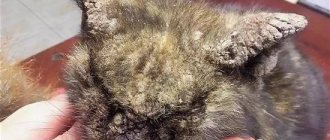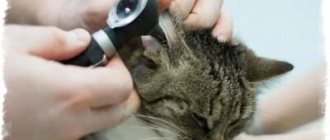A common cause of severe coughing in cats is asthma. It is a chronic inflammatory disease of the respiratory tract. A characteristic feature of this condition is the narrowing of the bronchi, which causes the animals to experience periods of prolonged dry cough. Experts from the Berloga veterinary clinic in Moscow talk about how to promptly recognize asthma in cats, and whether this disease can be completely cured.
Read in this article:
Why do cats develop asthma? Signs of asthma: what should the owner pay attention to? How does the disease develop? Diagnosis of asthma: methods and nuances Treatment of asthma in cats Recommendations for the owner How long do cats with asthma live? Disease prevention
Why do cats develop asthma?
Asthma most often develops in cats between the ages of 2 and 8 years. It is less common in kittens or older animals, but can still develop. The main causes of asthma in furry pets include:
- Allergy . In 70% of cases, the disease develops due to exposure to allergens. The most common factors that cause allergic reactions in cats of different ages include pollen, medications, food, litter trays and even cigarette smoke. Continuous or frequent exposure to allergens inevitably leads to the sensitivity of the animal’s lungs increasing significantly, and this entails the occurrence of asthma;
- Oncology . The next reason that can lead to the development of chronic respiratory tract disease in a cat is malignant neoplasms affecting the lung tissue. To find out whether asthma is caused by cancer, a chest x-ray is required during diagnosis. If malignant tumors are detected, their removal is prescribed. Only in this case will the cat’s condition be stabilized;
- Diseases of the respiratory system . Incompletely cured infections affecting the respiratory tract lead to weakened immunity of animals and provoke the development of repeated inflammatory processes in the bronchi. These include pneumonia (inflammation of the pulmonary alveoli), rhinotracheitis (herpes virus infection), cat flu, etc. As a result, a chronic disease develops - asthma.
Another reason that can cause asthma in indoor or outdoor cats is genetics. If we consider the hereditary factor, then the risk group most susceptible to the development of this disease is identified - Siamese and Himalayan cats.
On a note! For asthma to be passed on to offspring, one sick parent is enough. This fact must be taken into account when breeding cats.
Symptoms
The most obvious sign of asthma in a kitten is the appearance of wheezing and frequent coughing. The cat often breathes with its mouth open: it is difficult for her to inhale and exhale. A typical coughing position is a squatting position with the neck extended. After several days of attacks, the cat experiences a depressed and depressed state, loss of appetite, and drowsiness. The pet’s lifestyle changes significantly: less time for games and exploring the world around him, more time for sleep and apathy.
When the disease reaches its peak, the mucous membranes become bluish due to oxygen deprivation (cyanosis). The pulse increases, the cough is already painful and may be accompanied by a plaintive meow, the nose and lips turn pale, and the body temperature becomes slightly below normal. During an attack, the cat will not respond to its name; cases of aggression and anxiety, loss of consciousness are quite possible. If these symptoms are detected, you should immediately seek help from a veterinary clinic.
Read about choosing a clinic: How to choose the right veterinary clinic for a cat
Signs of asthma: what should the owner pay attention to?
The first thing that indicates asthma in a cat is a cough. At the same time, furry pets bend their paws and stretch their necks. The cough is quite strong and protracted, reminiscent of regurgitation of fur, so some owners ignore this symptom, attributing it to the animal’s normal behavior.
Symptoms of bronchial asthma in a cat:
- sudden coughing fits of varying duration,
- dyspnea,
- labored breathing,
- wheezing,
- fast fatiguability,
- lethargy,
- refusal of games and activities,
- loss of appetite.
In severe cases of asthma, oxygen deficiency (hypoxia) occurs. The level of oxygen in the body decreases, and the mucous membranes turn blue - cyanosis develops. In this case, immediate veterinary attention is required.
Stages of development
- Soft stage. Attacks can occur once every 1-2 months, and they last no longer than a minute. It is almost impossible to detect this degree of the disease, since attacks can occur during the absence of the owner.
- Middle stage. Attacks may also occur rarely, but are now accompanied by more severe symptoms. Therefore, this form of asthma can threaten the cat’s health.
- Difficult stage. Seizures can be fatal to your pet and occur 5-10 times a week. If nothing is done, then during the next attack the cat may simply die.
It is important for the owner to notice the pet’s illness at an early stage. Because if it gets to severe, then the pet may be in mortal danger.
How does the disease develop?
Asthma in cats develops gradually. It usually begins with a mild form, in which the frequency of coughing attacks is about 1-2 times a month. Many owners ignore this or simply lose sight of it when they are away from home (for example, at work or school). In the first stage of asthma, the cough lasts about 40-60 seconds, so the cat recovers quickly without outside help.
If you do not take any countermeasures at this stage and do not consult a doctor, the disease will continue to develop. This will entail an increase in the duration of coughing attacks, as well as the appearance of other symptoms (fatigue, loss of appetite, strange wheezing, etc.). You shouldn’t write off all these symptoms “at random” - this can lead to serious consequences, including suffocation.
Forecasts for the future
If you contact a veterinarian in a timely manner at the initial stage of the disease, the prognosis for a mustachioed patient is positive. Thanks to supportive therapy, his condition can be controlled without compromising his quality of life.
The opposite situation occurs when the disease was diagnosed too late or completely overlooked. Remember that owners are responsible for the health of pets. Never ignore warning signs, even if they seem minor to you.
Diagnosis of asthma: methods and nuances
The main rule is not to diagnose and treat asthma on your own! The fact is that this can distort the results of upcoming studies, confuse the veterinarian and worsen the already serious condition of your beloved pet.
On a note! There are no laboratory tests that can detect asthma with 100% certainty.
To make an accurate diagnosis, the veterinarian examines the pet, asks the owner several questions (how often coughing attacks occur, how long do they last, are there any other changes in the animal’s behavior), and also prescribes additional examinations:
- general blood analysis,
- radiography,
- bronchoscopy,
- cytological examination.
The results of these studies make it possible to differentiate asthma in cats from other diseases that have similar symptoms (for example, chronic bronchitis, malignant neoplasms, pneumonia).
Diagnostics in a veterinary clinic
Diagnosis of asthma is based on differentiating it from other respiratory tract pathologies that have a similar clinical picture - pneumonia, bronchitis, pulmonary failure.
In addition, heart disease, benign and malignant tumors in the chest area, nematodes in the lungs, and foreign objects entering the respiratory tract, including trichobezoars, must be excluded.
The veterinarian needs to conduct the following tests:
- General blood analysis. An allergic process will be indicated by an increased level of eosinophils.
- Stool analysis (if nematodes are suspected).
- X-ray. It does not apply to specific diagnostic methods, but it allows identifying the displacement of the diaphragm towards the abdominal cavity, characteristic of asthma.
The most informative criterion is cytological analysis of bronchial mucus. In asthma, it is always thick, forming plugs in the respiratory tract, cloudy, with a greenish tint.
Treatment of asthma in cats
Unfortunately, asthma has no cure. However, this is not a reason to do nothing and give up. Veterinary clinic specialists know how to control and prevent sudden coughing attacks that develop against the background of asthma.
One of the main tasks is to identify and eliminate allergens that lead to a deterioration in the pet’s condition. If asthma is triggered by allergic reactions, which are a common cause of the disease, then eliminating allergens will completely prevent attacks of prolonged asthmatic cough.
If the signs of asthma cause severe discomfort to the pet or his body is so weakened that it cannot fight the disease even if allergens are excluded, drug therapy is prescribed. The veterinarian assesses the pet’s condition and, based on the diagnostic results, prescribes medications:
- Bronchodilators (bronchodilators) . They are designed to quickly relieve asthma symptoms. They act by expanding the lumen of the bronchi, making breathing much easier. Typically, bronchodilators are prescribed by a veterinarian along with anti-inflammatory drugs - this ensures maximum effectiveness of treatment;
- Glucocorticosteroids . Hormonal drugs that help increase blood glucose levels. They are prescribed by veterinarians carefully, taking into account all the characteristics of the pet’s condition. Glucocorticosteroids increase glycogen production in the liver and enhance protein catabolism. However, their intake must be strictly controlled;
- Antibiotics . Prescribed during periods of exacerbation as an addition to the main therapeutic program. Antibiotics are intended to control secondary flora and eliminate bronchospasms. They are often used if asthma is caused by incompletely treated infections;
- Antihistamines . They relieve various signs of allergic reactions and prevent their development. Each cat will respond differently to a particular antihistamine, so in some cases it may be necessary to try multiple treatment options;
- Vitamin and mineral complexes . They contain vitamins and minerals necessary for the rapid restoration of the animal’s body, strengthening the immune system, returning physical activity and appetite. Such complexes speed up recovery and reduce the risk of complications.
Trust the treatment of bronchial asthma in a cat only to experienced veterinarians!
Will preventive measures help?
The listed preventive measures will not give a 100% guarantee of eliminating asthma, but will reduce the likelihood of its occurrence. They are mandatory for animals with a confirmed diagnosis, but will not be superfluous for healthy whiskers.
If your cat has been diagnosed with bronchial asthma, do not panic. Thanks to timely treatment and compliance with preventive recommendations, you can not only avoid complications, but also maintain the quality of life of your mustachioed pet at the same level.
The article is for informational purposes only. Contact your veterinarian!
Do you like the article? 201
Recommendations for the owner
Always have a first aid kit on hand to provide emergency assistance. Include in it all the medications that the doctor recommends (glucocorticosteroids, bronchodilators, antihistamines, etc.). These products, along with your veterinarian's prescriptions, should always be available so you can use them immediately.
Discuss with your veterinarian the possibility of using bronchodilators or other aerosol medications. Using inhalers with special attachments is much more convenient and, most importantly, faster. This means you can quickly eliminate the attack and reduce the risk of side effects when using steroids in tablet or injection form.
How is asthma diagnosed?
Diagnosis of asthma and bronchitis in cats
requires exclusion of other diseases that cause respiratory symptoms.
These diseases include infectious pneumonia (fungal, bacterial, parasitic), heartworm disease (cats are aberrant hosts for heart and vascular parasites in dogs), primary lung parasites, and oncological disease (either a primary lung tumor or metastases that spread to lung tissue from other body parts). “Diagnosis of asthma and bronchitis in cats requires the exclusion of other diseases that cause respiratory signs.”
Diagnostic tests will include a complete blood count (CBC), blood chemistry, stool test, and urinalysis. These tests will evaluate the cat's overall health and may provide clues as to the underlying cause. One type of white blood cell, the eosinophil, is commonly associated with allergic or parasitic conditions and its presence supports a tentative diagnosis of asthma.
In some cases, special tests will be done on stool samples to look for lungworm eggs or larvae. Additional diagnostic tests may include the following:
- Test for dirofilariasis.
This is a blood test that should be performed on any coughing cat. - Tests for feline leukemia virus (FeLV) and feline immunodeficiency virus (FIV).
These tests are useful in determining the overall health of a cat. - Chest x-ray (chest x-ray). There are several characteristic changes seen on chest radiographs in cats with asthma and bronchitis.
- X-rays can help rule out other lung and heart conditions. For example, diseases caused by heartworms and hookworms create specific suggestive lesions that can be seen on radiographs.
- Bronchoscopy with cytology and/or culture.
Bronchoscopy is a procedure, usually performed by a specialist, that allows the veterinarian to visualize the airway of a cat under anesthesia using a small fiber optic scope. Samples of mucus and cells lining the bronchi can be obtained for subsequent examination under a microscope and for culturing microflora. - Tracheal lavage.
Tracheal lavage involves “flushing” the trachea with a small amount of sterile saline solution, removing cells and mucus from the airways. This material can then be cultured for microorganisms and examined under a microscope. In most cases, the underlying cause cannot be identified despite a complete and thorough diagnosis. Even when the underlying cause is not identified, many cats can achieve an acceptable quality of life with medical guidance.
Disease prevention
It will not be possible to achieve a complete recovery of an animal with asthma, so your main task as the owner is to protect the pet from possible attacks of prolonged coughing. To do this, just follow simple recommendations from experienced veterinarians:
- carry out wet cleaning frequently,
- ventilate the rooms regularly,
- do not allow dust to accumulate,
- think about choosing a humidifier,
- use powders and other household products from the “Eco” category,
- carefully monitor your pet's diet,
- move house flowers and plants to the balcony - if possible,
- do not smoke indoors,
- choose non-dusty litter for the tray.
Remember that the life and health of your pet is in your hands!
Treatment and supportive care
The veterinarian determines how to treat asthma in a cat based on its condition.
For seasonal attacks that occur in a mild form, the use of medications is recommended, and for more frequent and severe attacks, an inhaler is recommended. Regardless of the chosen treatment method, to improve the pet’s condition, it will be necessary to completely review the existing care in order to reduce the likelihood of relapses.
Helping your pet during a seizure
If your cat has an asthma attack, try to calm down and remove all objects that could injure your pet. Keep children and pets away from it. Monitor the situation as it develops, noting symptoms, but do not move the cat until he feels better. After the cough stops, carefully place your pet in the carrier and go to the doctor.
For more severe symptoms that last more than 1 minute, it is better to call a veterinarian at home. When you call, check with your doctor about your symptoms. To alleviate the condition, you can use previously prescribed medications. If the attack is primary and there is no medicine, then just wait for the veterinarian to arrive.
Medicines
The only way to treat asthma in a cat is with medication. It involves the complex use of special aerosols that dilate the bronchi and hormonal drugs that fight inflammation. Antibiotics and vitamin complexes are prescribed in the presence of concomitant diseases.
Hormonal drugs are available in the form:
- tablets that have the longest lasting effect;
- injections with rapid action;
- aerosols, popular due to their ease of use at home.
Despite their convenience and safety (the medicine does not accumulate in the gastrointestinal tract and blood), inhalation masks with aerosol have a slow cumulative effect. In most cases, the veterinarian prescribes a lifelong course of glucocorticosteroids with a gradual reduction in dosage.
Specific care and reduction in the number of attacks
It is almost impossible to find the allergen that causes suffocation, so the owner can only minimize contact with possible irritants. To do this you need:
- Regularly carry out wet cleaning and ventilation.
- Limit the use of household cleaning chemicals and various sprays that your pet can inhale.
- Pour the toilet filler strictly under the lid or abandon it completely.
- Buy a humidifier to eliminate dryness during the heating season.
- Do not allow a mustachioed allergy sufferer to go for walks during flowering.
- Avoid stress at all costs. Do not leave your pet alone for a long time and give him enough attention.
- Stop smoking in the same room as your pet.
Maintain a balanced diet, excluding the main allergenic foods (chicken, corn, wheat gluten). Stick to recommended servings to prevent obesity. Excess weight is one of the factors in the development of respiratory tract diseases.
Get rid of carpets - the main sources of indoor dust.
If your pet has been prescribed medications, use them strictly as prescribed. Do not try to adjust dosages, buy a cheaper medicine, or stop using it when your condition first improves. All this can lead to serious complications.
Causes
In cats, asthma is of an allergic nature. Provoking factors may include:
- dust;
- household chemicals;
- mold;
- fur of other pets;
- cigarette smoke;
- perfumes and cosmetics.
Other causes of the disease:
- parasites;
- bacteria;
- pathogenic viruses.
In addition, any environmental substance can become a provoking factor leading to such an intense reaction of the bronchi, which makes diagnosing the allergen extremely difficult.











